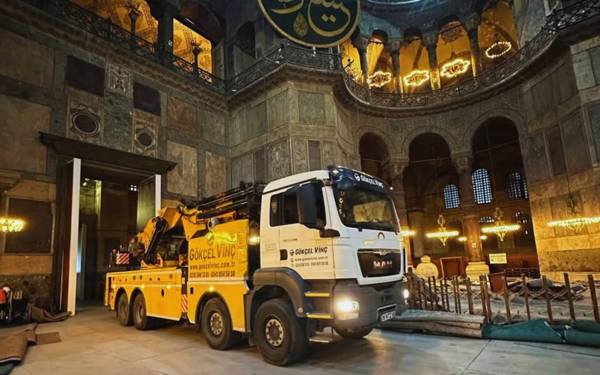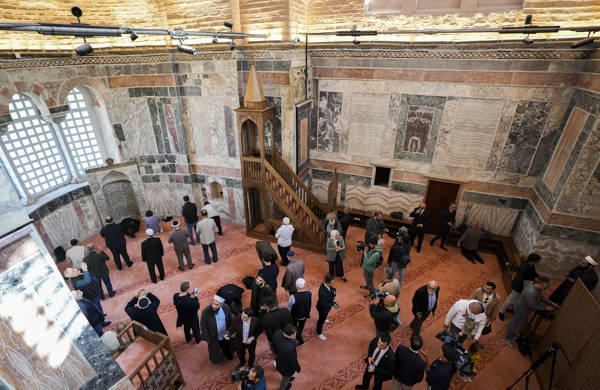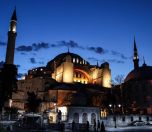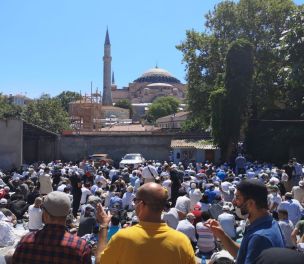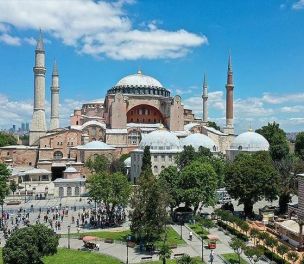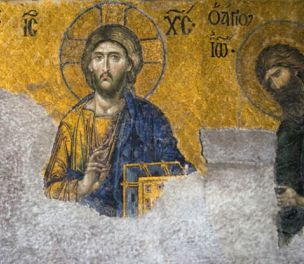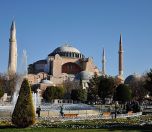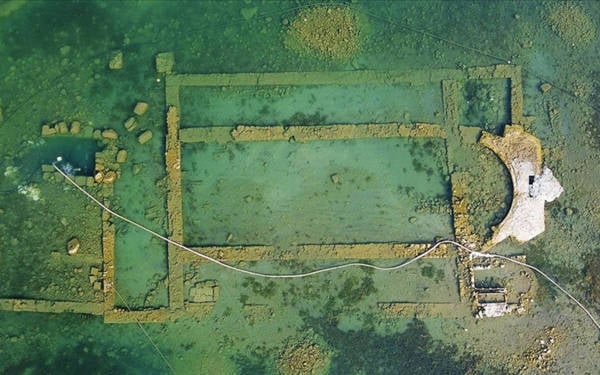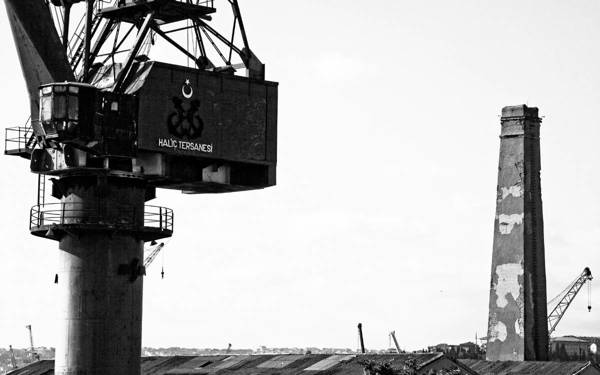Click to read the article in Turkish
What welcomes us on the way to Hagia Sophia is a sign that reads "The Grand Hagia Sophia Mosque" (Ayasofya-i Kebir Cami-i Şerifi), and then the police barricades. The high number of police officers and checkpoints on the roads leading to Hagia Sophia are noteworthy.
When we ask why there are so many police officers, a person working at a buffet on Sultanahmet Square says, "It's been like this since it became a mosque."
There is a long queue at the entrance. It is possible to come across people from any nationality along the queue. And tourist guides and scarf sellers...
The vendors who try to speak to us in English and Germany because they think we are tourists say the price of a scarf is 125 lira (~8.1 US dollars). When they see us speaking Turkish, they say they will sell it for 50 lira.
No entrance to the upper floor
If you are a woman, you need something to cover your hair. Because security guards ask you to cover your hair not only in the mosque but also as soon as you enter the yard. If your hair is still visible or became visible by mistake in the mosque section, they come to warn you.
There is no longer an entrance fee for Hagia Sophia. Before it was converted into a mosque, it was 100 lira per person. Nevertheless, there is no museum you can visit, either. The upper floor of the building is closed to visitors. When we ask whether we can visit the upper floor, security guards say, "There is no entrance to the upper floor. You need to get permission from the governor's office."
The Official Gazette

When you enter Hagia Sophia, a printout of the issue of the Official Gazette containing the president's decree to convert Hagia Sophia into a mosque welcomes you. The building confirms the realization of the plan that the government has been talking about for years. Even though putting the document at the entrance initially seems absurd, it is a signed statement of years of effort.
Tourists who visit Hagia Sophia all day long and those who gather for Friday prayers have to take off their shoes when entering the mosque. The photos of "shoes in a historical water chamber" come to our minds. Then we realize that a pair of shoes left in a secluded corner away from the entrance is not a very successful attempt at concealment.
The Ladies Section
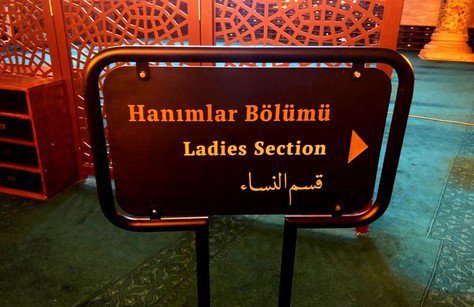
We put our shoes in one of the dozens of small cabinets that can be seen in every corner of the mosque.
At the entrance, there are the "Ladies Section" and the "Men's Section."
We enter the Ladies Section. There is a strong odor in the mosque.
A thick green carpet is laid inside, covering the entire floor. There is a zone around which strips are drawn, leaving only a small portion of the floor open. People lie on the floor when taking pictures in order to be able to frame the ceiling; they just leave their coats on the red stripes surrounding the closed area.
.jpg)
The red Hello Kitty balloon
Inside the women's place of worship, shattered windows, a red Hello Kitty balloon hanging in the air and children running around meet the eye. We see the destruction in one of the entrance doors.
.jpg)
Green flags are hung on both sides of the minbar that was built in the 16th century. They were used as a symbol of conquest in the Ottoman era.
Panels are piled up in places reserved for worship and around the minbar.
.jpg)
Covered mosaics
The mosaics are covered with curtains. The most striking of these is the "Virgin Mary and Child Jesus" mosaic. The mosaic, which stands in a central position in Hagia Sophia, is located in the section called Apsis.
Another thing grabbing attention is that the Seraphim Angels are not covered.
The angels, which are located in the triangular section supporting the dome of Hagia Sophia, musharifin in Arabic, have an important place in Islam.
.jpg)
The historical millstone in the garden is dated 1743. It is from the Ottoman era. Now there are wet wipes and all kinds of garbage in it. Apparently, it couldn't be thought that it was a historical stone and had been preserved for centuries.
.jpg)
"It's nearly impossible to see women"
We are chasing tourists at Sultanahmet Square to ask them about the indifference regarding this building that is considered a historical monument and is called to be protected all over the world.
One of the two tourists from Poland whom we speak to says they were surprised that there were so many men.
"It's nearly impossible to see women. Men and women enter [the mosque] from different places. That seems a bit odd to me."
The other one says they liked Hagia Sophia, which brings different cultures together.
"I didn't visit this place when it was a museum, so I only know how it is now. Hagia Sophia used to be the sacred place of Christians. And now, it is in an interesting place that brings different cultures together, and it was nice to witness that."
Hagia Sophia's conversion into a mosqueHagia Sophia was used as a church for 916 years. In 1453, it was converted into a mosque by Ottoman Sultan Mehmed II when the empire took over İstanbul. Under the Republic of Turkey, it became a museum. The Permanent Foundations' Association for Serving Historical Artifacts and Surroundings appealed to the Council of State in 2005, challenging the status of Hagia Sophia in a lawsuit. The association demanded the stay of execution and the annulment of the Council of Ministers decree dated 1934 that paved the way for the Hagia Sophia's conversion into a museum. The 10th Chamber of the Council of State rejected the request for a stay of execution on June 24, 2005. In 2008, it rejected the lawsuit on the grounds that the use of Hagia Sophia as a museum was not against the law. The Council of State's Plenary Session of Administrative Law Chambers upheld this verdict. The Association filed another lawsuit in 2016. The Constitutional Court concluded the individual application of the Association in 2018. While the Association claimed that freedom of thought and faith was violated, the court found the application "inadmissible" due to "ratione personae non-jurisdiction without being examined." The 10th Chamber of the Council of State, on July 10, 2020, announced that it annulled the Council of Ministers Decree, which was dated November 24, 1934, and turned Hagia Sophia from a mosque into a museum. Shortly after this verdict was announced, the Presidential Decree handing Hagia Sophia over to the Presidency of Religious Affairs and opening it to worship as a mosque was published in the Official Gazette. In the decree of the President published on the Official Gazette on July 10, a reference was made to the annulment of the Council of State. Hagia Sophia reopened as a mosque on July 24, 2020, with the Friday prayers attended by several top state officials, including Erdoğan. |
(TY/MD/VK)






.jpg)
